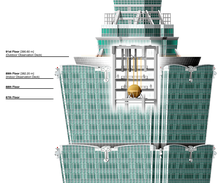Vibration control
In earthquake engineering, vibration control is a set of technical means for decreasing seismic loads and improving seismic performance of building structures.


Types of vibration control devices
changeAll vibration control devices may be classified as passive, active [1] or hybrid.[2] The first kind is the simplest one and, therefore, widespread. Passive control devices represent different types of base isolators and seismic dampers.
Base isolators restrict penetration of potentially damaging seismic waves into a building structure while dampers decrease destructive effect of those waves.
Wikimedia Commons has media related to Structural control.
Other websites
changeReferences
change- ↑ "PASSIVE AND ACTIVE VIBRATION ISOLATION SYSTEMS". Archived from the original on 2007-02-04. Retrieved 2010-03-24.
- ↑ Chu, S.Y.; Soong, T.T.; Reinhorn, A.M. (2005). Active, Hybrid and Semi-Active Structural Control. John Wiley & Sons. ISBN 0470013524.
{{cite book}}: CS1 maint: multiple names: authors list (link)